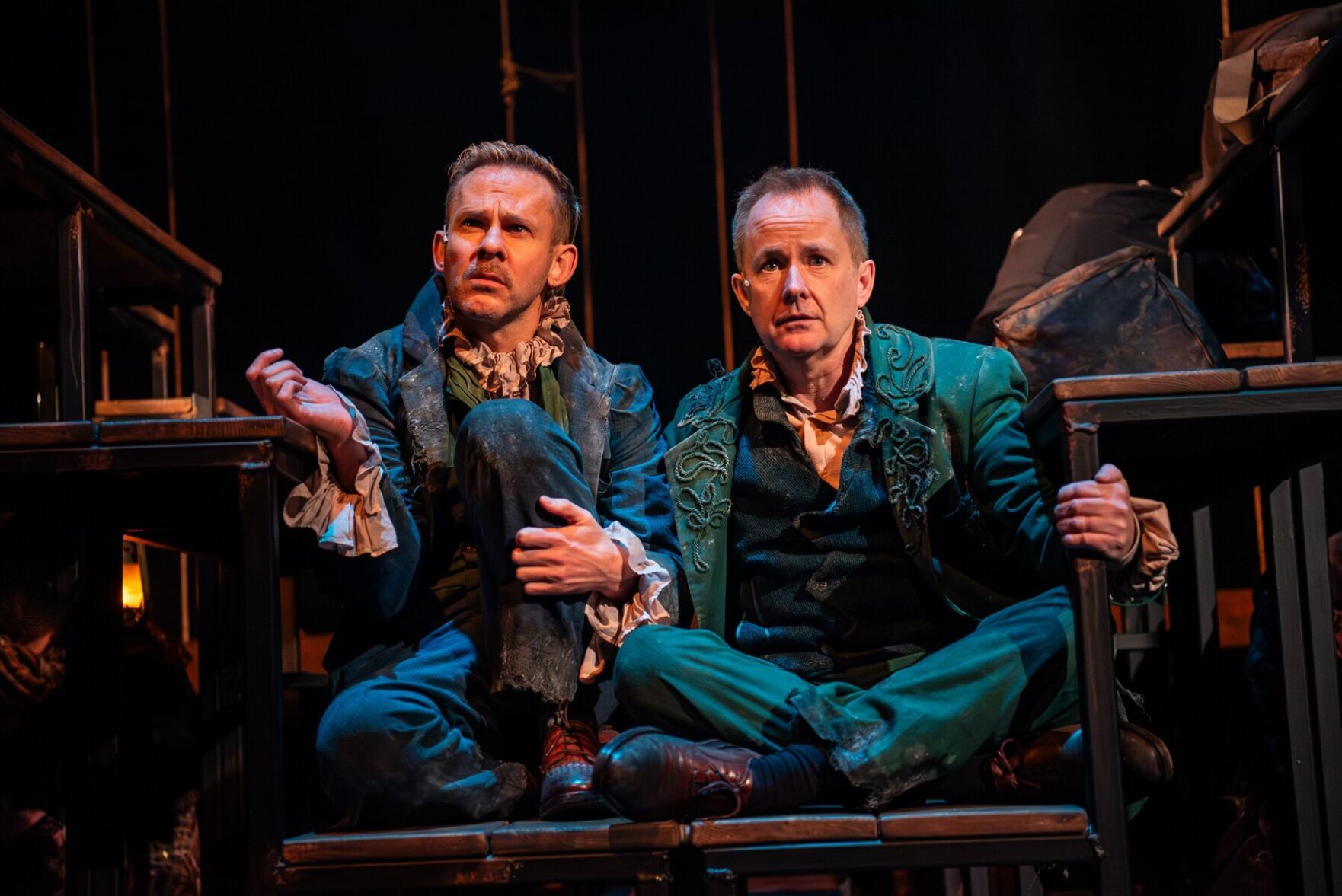Rosencrantz and Guildenstern Are Dead
3.5 stars (out of 4)
By Tom Stoppard, directed by Jeremy Webb. Until April 6 at the CAA Theatre, 651 Yonge St. or 1800-461-3333
“Rosencrantz and Guildenstern Are Dead,” the 1966 tragicomedy that launched the career of British playwright Tom Stoppard, begins rather innocuously. Its titular pair of fools are flipping coins. One … and then another … and then another.Â
Yet something’s amiss with this charade, as flip after flip yields a string of heads — 76 consecutive times and counting. It’s the first hint that the following 170 minutes of Stoppard’s three-act play will be nothing close to rational.
The playwright’s breakthrough work is, in fact, an absurdist drama, offering a side story to Shakespeare’s “Hamlet” that follows the adventures of Rosencrantz and Guildenstern, two of its minor characters.
Amid the absurdity of the play’s fictional world, little is certain. Rosencrantz and Guildenstern and unsure of their identities, frequently confusing their names. And whether they possess free will or are controlled by “un-, sub- or supernatural forces” is also up for debate (and makes for the play’s most hilarious monologue, delivered by Guildenstern, whose philosophical tangents fuel much of the humour and form the heart of the work).Â
But in th¾±²õÌýimpressive production of “Rosencrantz and Guildenstern Are Dead,” which opened Sunday at the CAA Theatre, one thing ¾±²õÌýfor certain: the play’s central performances are nothing short of stupendous.
I’m referring, of course, to Dominic Monaghan and Billy Boyd, who played Merry and Pippin in “The Lord of the Rings” trilogy and have reunited to tackle the roles of Rosencrantz and Guildenstern, respectively.Â
It’s quite the coup that Mirvish Productions and Halifax’s Neptune Theatre — which mounted this production before it transferred to ÎÚÑ»´«Ã½ — managed to secure both actors. They’re clearly a draw for the box office. (The play’s current run in ÎÚÑ»´«Ã½ was extended twice before it even opened). Plus, with a friendship and professional partnership stretching back more than two decades, they feel ideal for the roles.Â
Indeed, that’s evident right from the play’s opening scene. Endlessly watchable, they possess a chemistry that feels wholly natural, a perfectly calibrated double act, balancing the levity of the humour with the dark existentialism coiled underneath.Â
To make it appear so effortless is no easy feat in this play. The text, fast and quippish, is like a high-speed racquet game, with barbed lines of dialogue and pithy jokes launched back and forth. But both actors never drop the ball, even when Stoppard’s drama falls into an occasional lull in the second act.Â

Michael Blake (centre) as The Player in “Rosencrantz & Guildenstern Are Dead,” now playing at the CAA Theatre until April 6.
@stoometzphoto/Mirvish ProductionsBoyd’s performance as the analytical Guildenstern feels appropriately cerebral, as the character ties himself into knots over questions of death, fate and consciousness.
Monaghan’s Rosencrantz, meanwhile, is almost a foil to his friend. Where Guildenstern attempts to change the course of his fate, Rosencrantz seems resigned to the futility of it all.Â
It’s no spoiler to share that, ultimately, there is no escape for either of them, with both characters meeting their untimely ends, as is the case in “Hamlet” and as the play’s title suggests.
But that hope — carried by both the audience and Guildenstern — that something could change, that some notion of “free will” can alter the course of their fates, is what lends the play its urgency. After all, we all cling to a hope that we have control of our destiny, don’t we?Â
Rosencrantz and Guildenstern are on stage for the entirety of the play. Shards of original scenes from the Bard’s play intersect with Stoppard’s dialogue, as the play hurtles alongside “Hamlet” to its tragic conclusion.Â
The pair often interact with other characters from the Shakespearean tragedy, including Hamlet (Pasha Ebrahimi), Polonius (Walter Borden), Claudius (Jonathan Ellul), Gertrude (Raquel Duffy) and Ophelia (Helen Belay). Though here, those leading roles are now minor characters.Â
As the Player, leader of the acting troupe that performs in Hamlet’s court, Michael Blake delivers a magnetic performance. His presence is mercurial, underscoring how the shape-shifting Player is far wiser and all-knowing than he lets on. (As someone familiar with Blake’s work at the Stratford Festival over the past decade, I’d rank his supporting turn in this production up there with his best Shakespearean performances.)
So strong are the performances by Monaghan, Boyd and Blake that it often feels that the rest of the ensemble rarely rise to their level.Â
But the director Jeremy Webb’s physical production more than makes up for those occasionally uneven performances, making striking use of the CAA Theatre stage.
Andrew Cull’s brooding set is comprised of two wooden risers that are effectively wheeled around to form various structures. Combined with Leigh Ann Vardy’s lighting and Kaelen MacDonald’s costumes, it creates an esthetic of decay, leaning into the existential themes central to the play.Â
These are dark themes, no doubt. And Stoppard’s play is not one to shy away from death. But in this production, bolstered by a trio of brilliant performances, there’s also much life.Â




























To join the conversation set a first and last name in your user profile.
Sign in or register for free to join the Conversation